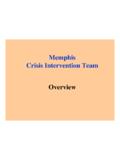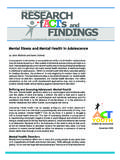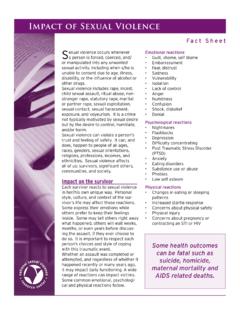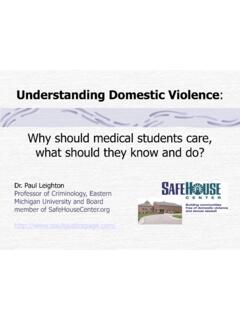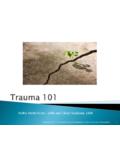Transcription of The Heart of - k12.wa.us
1 The Heart of Learning and Teaching: Compassion, Resiliency, and Academic Success F PUBL. TO IC. EN. D. IN. PERINTEN. ST. RU C T I O N. SU. W. AS N. HINGTO. Written by: Ray Wolpow, Mona M. Johnson, , CDP. Ron Hertel, Third Printing Susan O. Kincaid, May 2016. For information please contact: Ron Hertel Ray Wolpow Of ce of Superintendent of Public Instruction Woodring College of Education Old Capitol Building Western Washington University 600 Washington St. S. 516 High Street, Miller Hall 401B. Olympia, WA 98504-7200 Bellingham, Washington 98225-9089. 360-725-6050 360-650-3337. Mona M. Johnson Susan Kincaid Of ce of Superintendent of Public Instruction Human Services and Rehabilitation Old Capitol Building Woodring College of Education 600 Washington St. S. Western Washington University Olympia, WA 98504-7200 516 High Street, Miller Hall 317E.
2 360-725-6050 Bellingham, Washington 98229. 360-650-3531. Copyright 2009 by Washington State Of ce of Superintendent of Public Instruction (OSPI) Compassionate Schools. All rights reserved. No part of this book may be reproduced without permission of OSPI. All photographs are for illustration purposes only and do not represent real life situations. Cover Art: Dale Gottieb Publication Layout: Brigid Slinger and Linda Bull Final Copy Edit: Niquette Kelcher Funding for this document was made possible in part by the Mental Health Transformation State Incentive Grant Award No. 6 U79 SM57648 from the Substance Abuse and Mental Health Services Administration (SAMHSA) to the State of Washington. The views expressed in this document do not necessarily re ect the of cial policies of the Department of Health and Human Services or agencies of the State of Washington, nor does mention of trade names, commercial practices, or organizations imply endorsement by the Government.
3 Copies may be downloaded from Dedication This book is dedicated to our students, colleagues, and their families: those whose lives are affected by trauma, and those who are working to make a difference. To those children and adolescents struggling with the pain and isolation of traumatic events, this book was written with your stories close to our hearts. We care and are committed to making school a more supportive place for you. To those educational professionals and community members who seek to foster resiliency and academic success, this book is intended to recognize your inspirational work. Your compassion and pervasive caring reaches beyond the walls of your classrooms. Table of Contents Table of Contents xiii Chapter 1: Trauma, Compassion, and Resiliency: Background and De nitions The Language of This Chapter.
4 2. Introduction Trauma and Academics: Playing Chess in a Hurricane .. 3. Just How Pervasive Is the Problem? .. 4. ACEs and School Performance .. 5. The Nature of Trauma Symptoms of Trauma: When the Solution Becomes The Problem .. 8. Trauma and the Brain: The Neurobiology of Trauma .. 9. How Trauma Affects Learning .. 12. Meeting the Challenge: Background Knowledge for Finding Solutions The Nature of Resiliency .. 14. The Nature of Compassion .. 17. A Working De nition of Compassionate Schools .. 18. An Ecological View of Trauma and Resiliency .. 19. Healing from Trauma in Other Cultures .. 21. Trauma and Gender .. 27. Compassion Requires That We Be Responsive and Relevant .. 28. How Trauma Affects Those Who Care: Vicarious (Secondary) Trauma .. 29. Summary .. 30. Chapter 2: Self-Care: An Ethical Obligation for Those Who Care The Language of This Chapter.
5 38. The Cost of Caring Secondary (Vicarious) Trauma, Compassion Fatigue, and Burnout ..39. The Ripple Effect ..40. Possible Negative Consequences of Vicarious Trauma ..41. The Personal Impact of Vicarious Trauma ..42. The Professional Impact of Vicarious Trauma ..43. v Chapter 2 (cont.). One Other Sign of Compassion Fatigue: The Silencing Response ..44. Can't Teach What You Don't Know. Can't Lead Where You Won't Go ..45. Prevention and Self-Care How Are You Doing? The Professional Quality of Life Scale (ProQOL R-IV) 46. Check Your Batteries: A Self-Care Checklist With Suggestions ..48. Building a Self-Care Action Plan ..58. An Ethical Obligation for Those Who Care ..60. Summary ..61. Chapter 3: Instructional Principles, Curricular Domains and Speci c Strategies for Compassionate Classrooms The Language of This Chapter.
6 67. 68. Compassionate Instruction and Discipline in the Classroom Principle One: Always Empower, Never Disempower .. 72. Principle Two: Provide Unconditional Positive Regard .. 72. Principle Three: Maintain High Expectations .. 73. Principle Four: Check Assumptions, Observe and Question .. 74. Principle Five: Be a Relationship Coach .. 75. Principle Six: Provide Guided Opportunities for Helpful Participation .. 76. A Compassionate Curriculum A Suggested Framework: Research-based and Modeled on Current Best Practice .. 79. Domain One: Safety, Connection and Assurance Domain De ned .. 81. Goals for Instruction .. 82. Recognizing the Need .. 82. Applying the Six Principles .. 83. Content and Strategies Safety First .. 84. Monday Mornings, Daily Schedules and Class Meetings .. 84. Identifying and Dealing With Triggers.
7 86. Transitions and Safety Plans .. 88. Minimizing Triggers When Setting Limits .. 89. Calm Zones .. 89. Removing Triggers in the Secondary Classroom .. 90. Testing as a Safety Issue .. 91. Fancy Fridays, Photo Scrapbooks .. 92. vi Domain Two: Emotional and Behavioral Self-Regulation Domain De ned ..93. Goals for Instruction ..94. Recognizing the Need ..94. Applying the Six Principles ..95. Content and Strategies ..96. The Vocabulary of Feelings ..96. Practice in Using the Vocabulary of Feelings ..96. Categories of Affect ..97. Using Analogies to Describe Emotions and Triggers ..99. Teaching Affect Calming the Body and Mind with PMR and Yoga ..100. Calming the Body and Mind: Games for Young Children ..102. Empathy/Listening Skills ..102. Listening With Empathy: an Exercise ..103. Domain Three: Competencies (of Personal Agency, Social Skills, and Academic Skills).
8 Domain De ned ..108. Goals for Instruction ..109. Recognizing the Need ..109. Applying the Six Principles ..109. Content and Strategies .. 110. Assertiveness Skills .. 110. Giraffe Talk: Non-Violent Communication .. 113. DEAR MAN: Interpersonal Effectiveness .. 116. Fair 117. Poetry (Cinquains, Biopoems and Diamante Poems) .. 117. Journal Writing (Personal, Worry Lock-Box, Dialogue and Double Entry) ..121. Risky RAFT: Role, Audience, Form and Alphabet Books ..125. Additional Curricular Resources Sheltered Instruction Observation Protocol ..126. Dealing with the Stress of Military Deployment ..126. 129. vii Chapter 4: Building Compassionate School-Community Partnerships That Work The Language of This Chapter ..134. Schools In Partnership ..135. Connecting Education and Community-Based Resources Mental Wellness Coordination.
9 137. Diversity and Strengths-Based Problem Solving ..139. Mental Health Terminology ..140. School-Community Partnerships That Work ..145. Readiness to Learn ..147. Dropout Prevention/Reduction Even Start ..153. Before and After School Programs ..155. Prevention and Intervention Services Program ..156. School Safety Coordinated School Homeless Institutional Education ..162. School Health Services and School Nurses ..163. Compassionate Schools Forming a School-Community Partnership Strength-Based Problem Solving and Asset Maps ..168. The Case for Needs Strategic Planning ..170. De ning School and Community Roles ..171. Managing the Growth of Community Partnerships ..172. Quick Strategies for Building Collaborations ..173. Summary ..174. Table of Contents viii Chapter 5: Examples of Compassion, Resiliency, and Academic Success Direct From the Field 179.
10 Three Student Voices Open Your Eyes, .. 180. All Youth Have Something an Adult will Never Have ..At Least Not Again, .. 181. A Safe Place to Learn .. 182. Two Case Studies Zach .. 183. Chucho .. 186. Six Vignettes from the Field Andy, the Resilient Kid .. 189. Ric and Doug .. 191. I Just Want to Give Him a Hug and Tell Him What a Wonderful Boy He Is .. 192. That's My American Dream .. 193. Compassion Fatigue: Implications for School Nurses .. 195. Trauma-Sensitive Learning and Teaching at an Alternative High School ..196. Chapter 6: Resources Printed Matter: Books and Journal Articles .. 202. Books and Journal Articles Online .. 206. Websites .. 207. Of ce of Superintendent of Public Instruction (OSPI) Resources .. 209. About the Authors .. 212. Acknowledgements .. 214. ix Preface Why do we suspend and expel so many students?

